Nine days ago at Farmington Bay the weather and the light were uncooperative but this female American Kestrel more than made up for it.
(Note: I needed twelve images to tell this story so don’t be surprised if this post takes longer than usual to load.)
The first time I encountered the kestrel she was stoically enduring the cold and falling snow as she perched on an old piece of metal alongside the road.
But when I returned 13 minutes later she’d had a successful hunt and was beginning to enjoy her American Pipit meal on another nearby piece of metal.
Because feathers are sticky to begin with and that tendency was exacerbated by the wet snow, she had more trouble than usual with them. They stuck to her face and her feet especially. Here she’s scratching feathers away from her beak with her right foot.
After feeding for a while, for some reason she chose to remove the pipit from under her feet and let it dangle down precariously as she held on to a couple of wing feathers with her beak. That was a mistake…
because she dropped it into the soft, fluffy snow where it almost disappeared. Here she’s looking down at it and trying to figure out what her next move will be.
I tend to notice and appreciate little things in my images. When flight feathers fall they tend to fall quill end first and that’s exactly what happened here, as we can see two of them stuck in the snow vertically as a result.
She turned around on her perch and then plunged into the snow for the pipit.
She struggled in the snow for several seconds and then turned in a way that suggested that her intention was to return to the original perch with her prey.
At this point I assumed that she had the pipit grasped in her feet…
but all she came up with was feathers and a face full of snow. She was apparently unable to pull the pipit out of the deep snow.
But she was persistent and went down for the bird again, this time grasping it in her beak instead of her feet.
All the while this little drama was playing out there was a nearby air boat warming up (duck hunters) and the noise was deafening so she’d apparently had enough of that and flew off with the pipit to find a quieter perch to enjoy her meal (this is the first time I can recall seeing a kestrel carry prey this large in their beak in flight).
She flew around with the bird for a few moments but every available perch was covered with several inches of soft snow and apparently not to her liking. She couldn’t eat the pipit on the ground for the same reason but she proved her resourcefulness when she found…
a sheltered nook under an old piece of concrete where she could finish her meal in a quieter and more protected spot. At this point I left so she could eat in peace and when I returned a little while later she was gone.
This is apparently the same bird as in my post of Dec. 16 and I’ve seen her in the same area every morning I’ve been there except once. I think (hope) she’s a survivor!
Ron


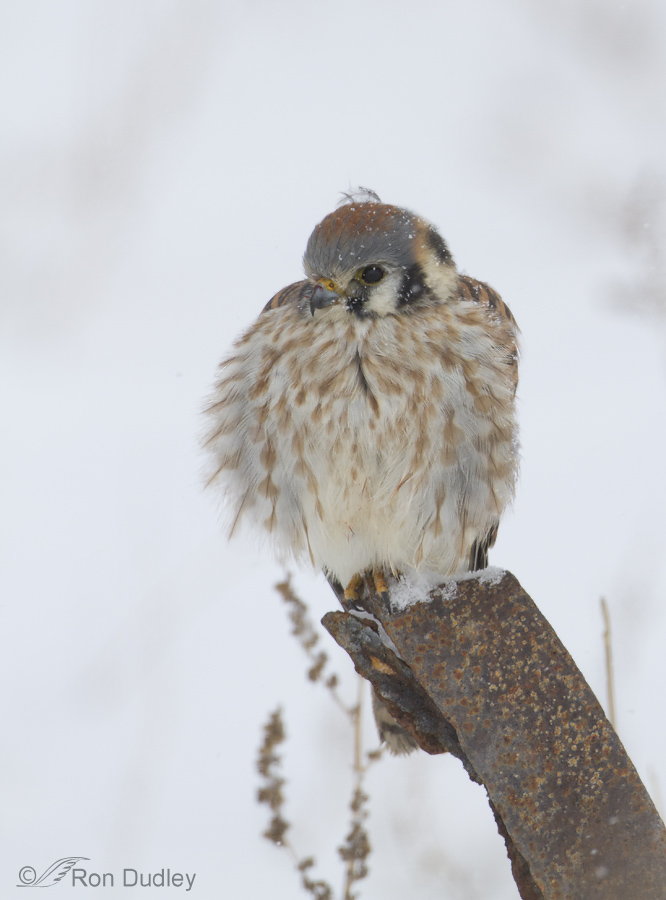
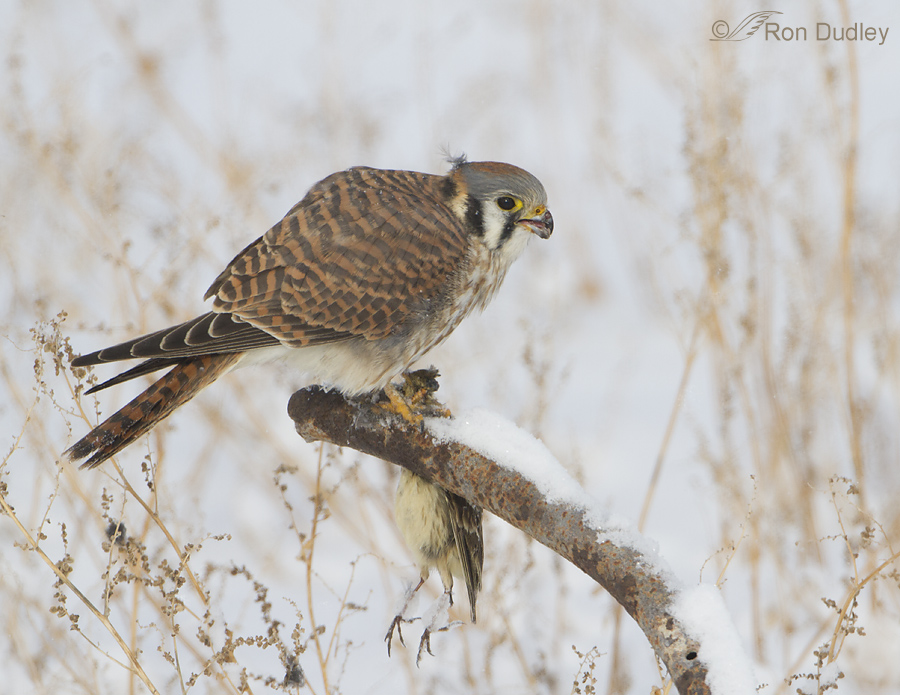
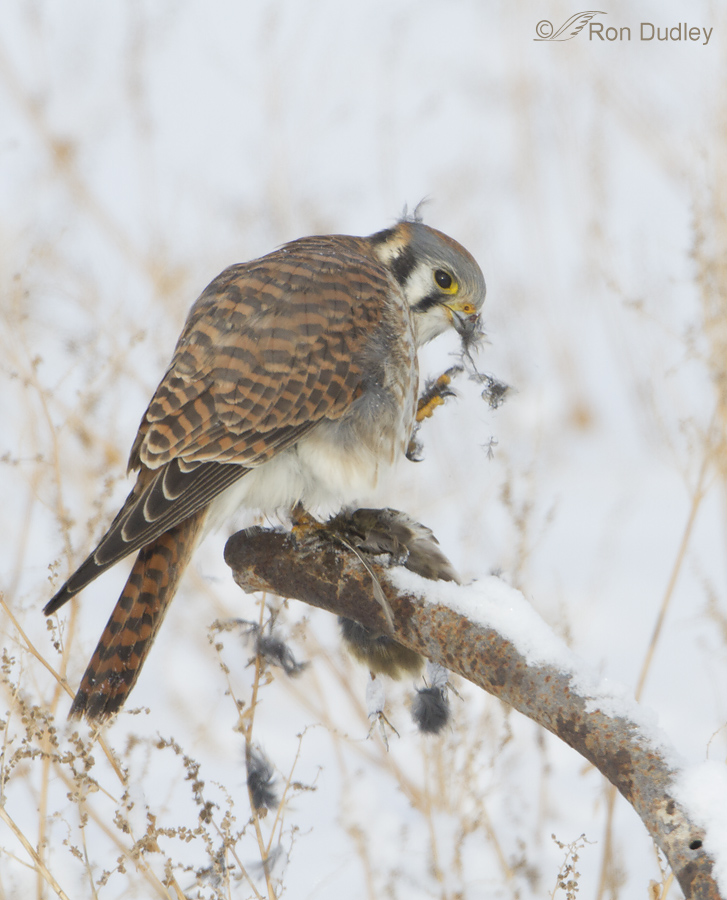
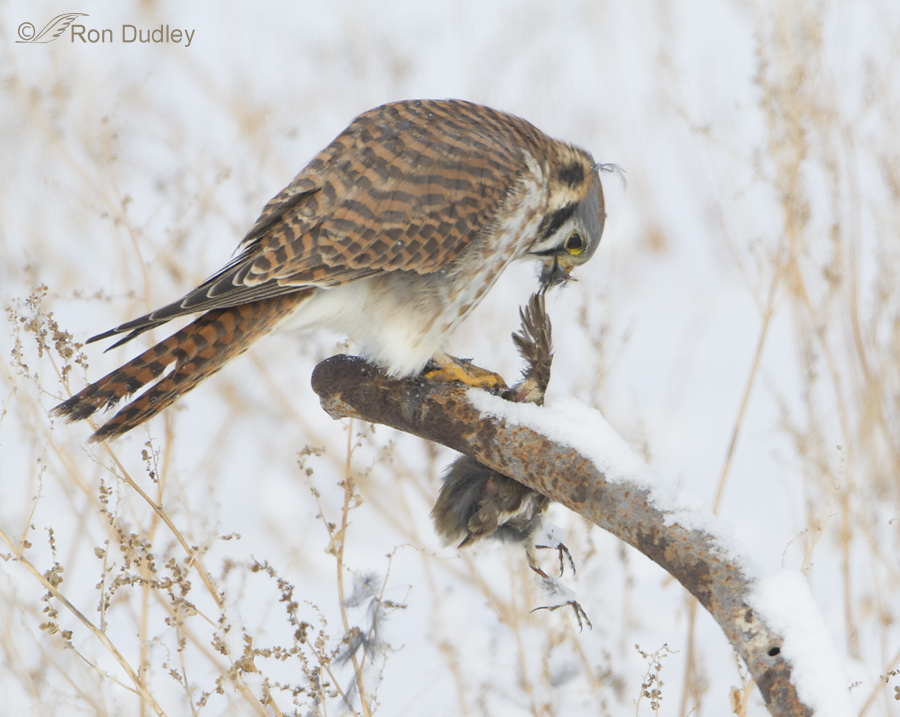
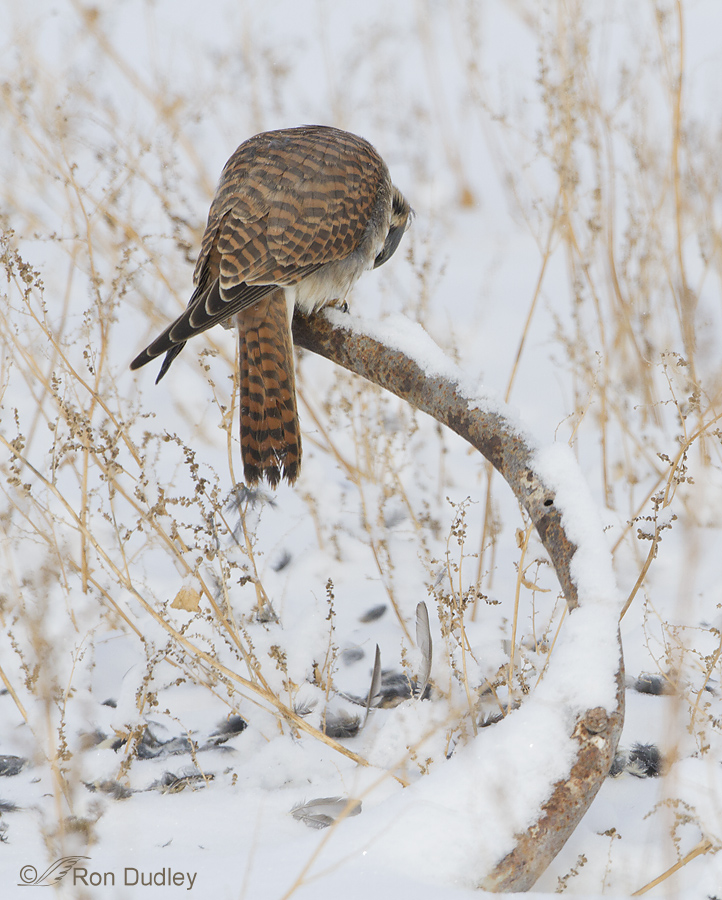
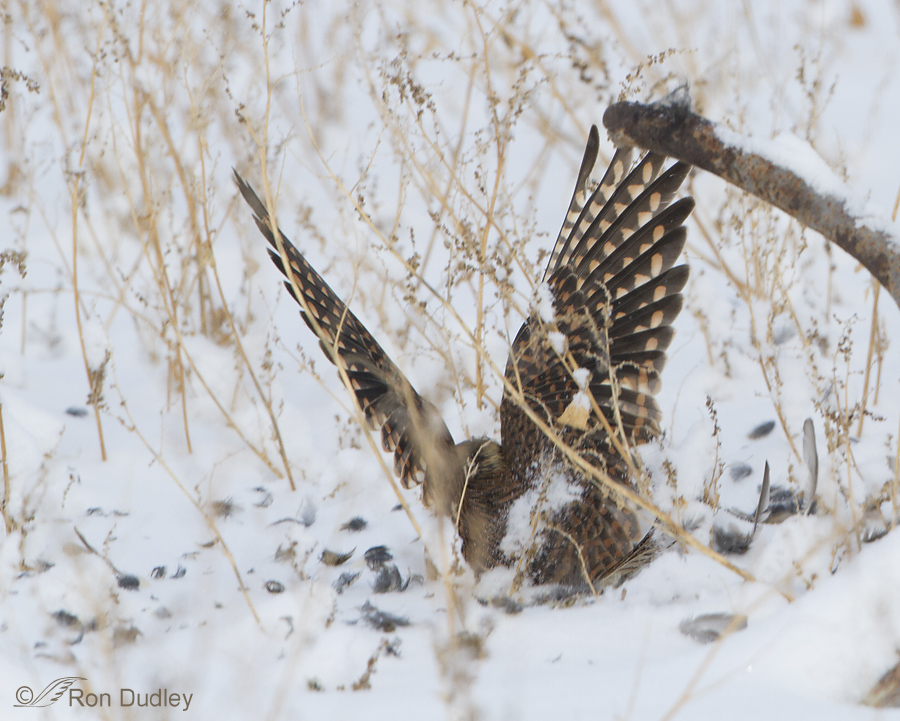
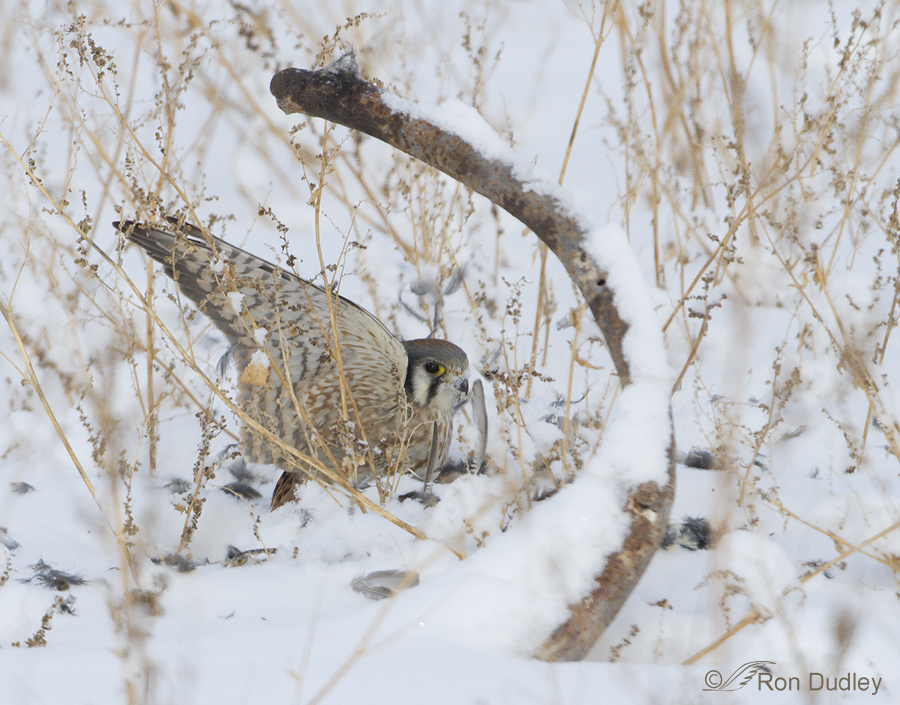
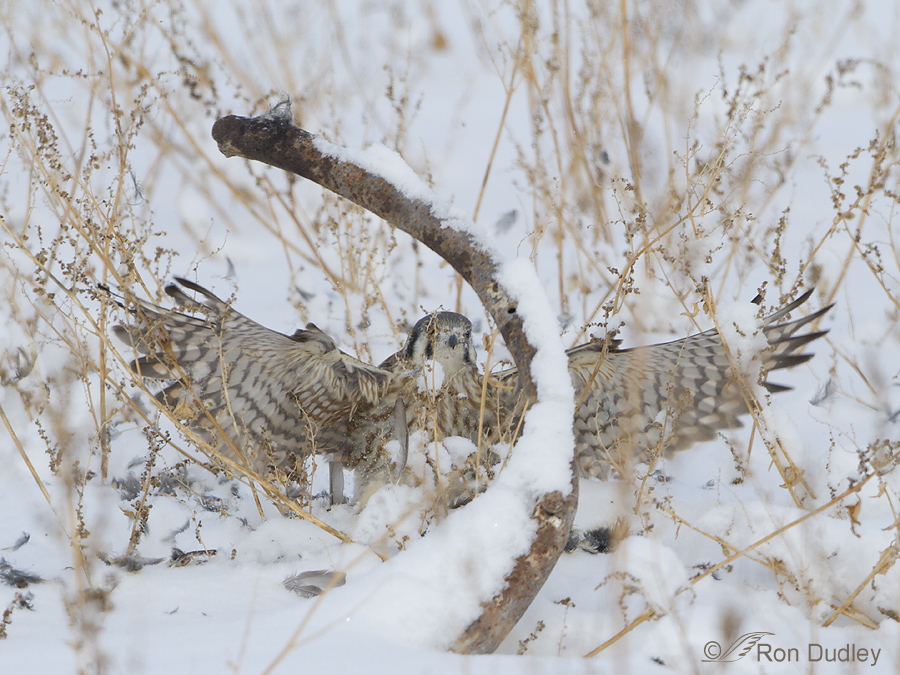
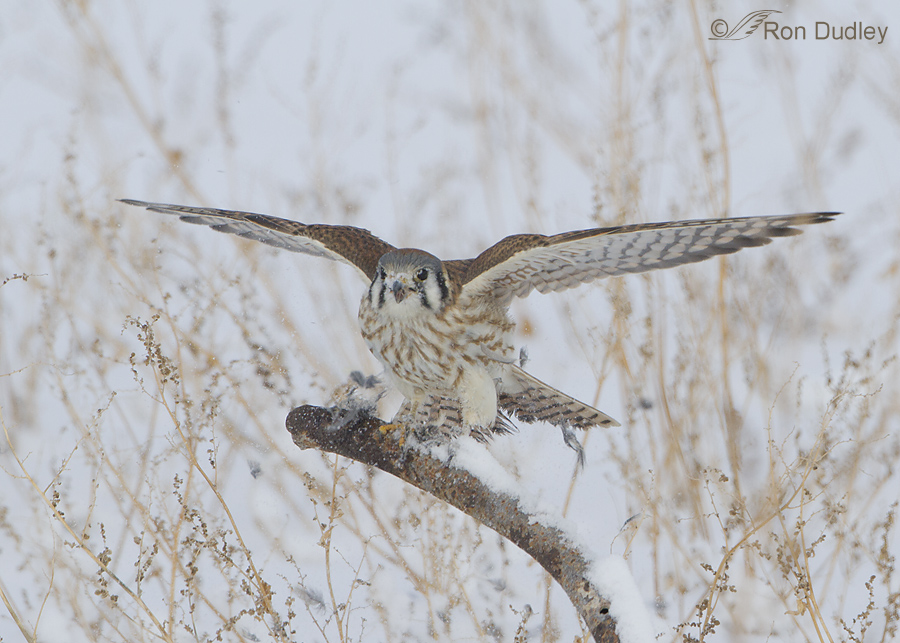
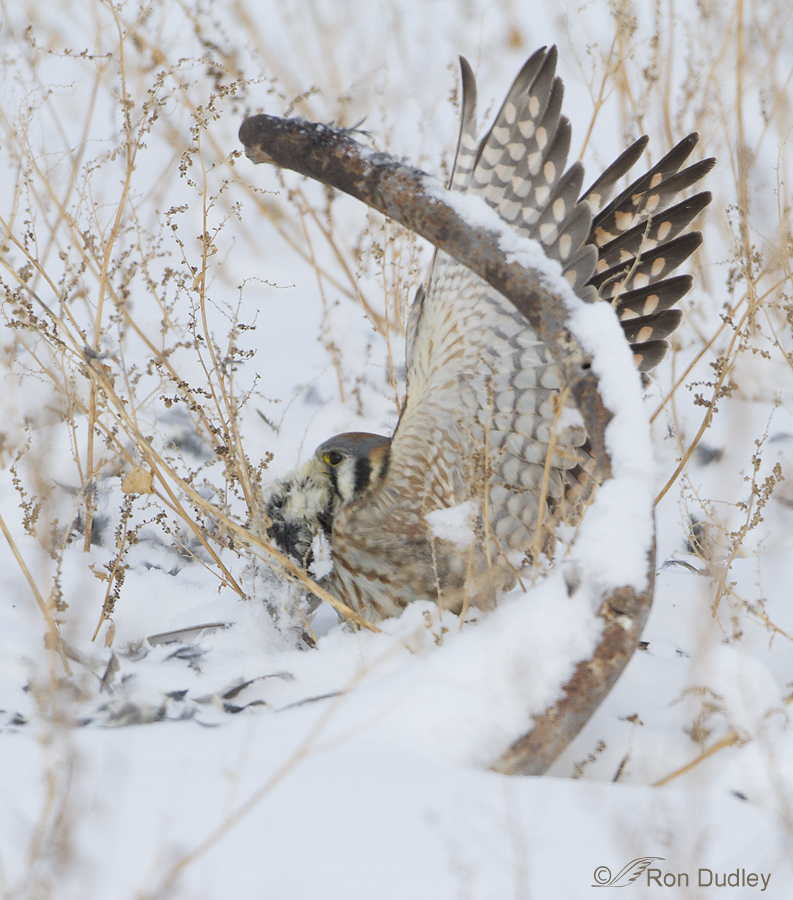
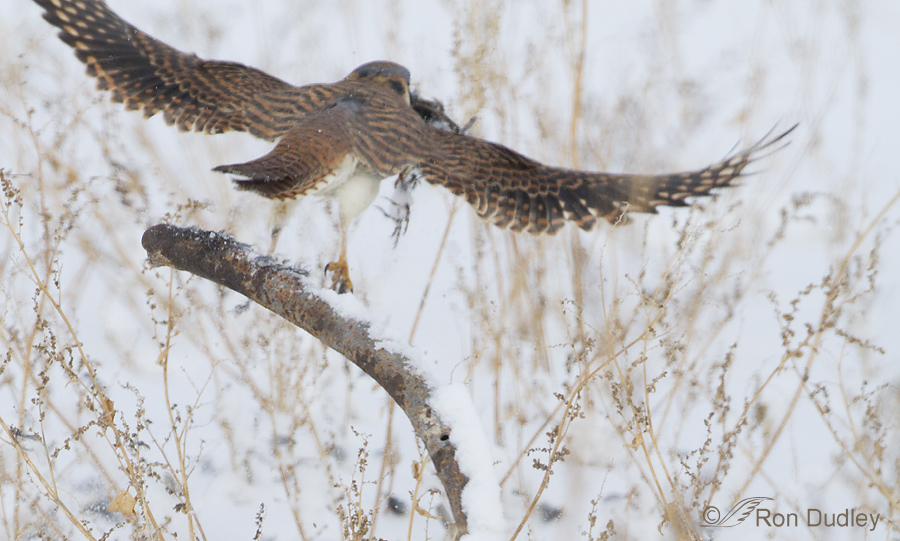
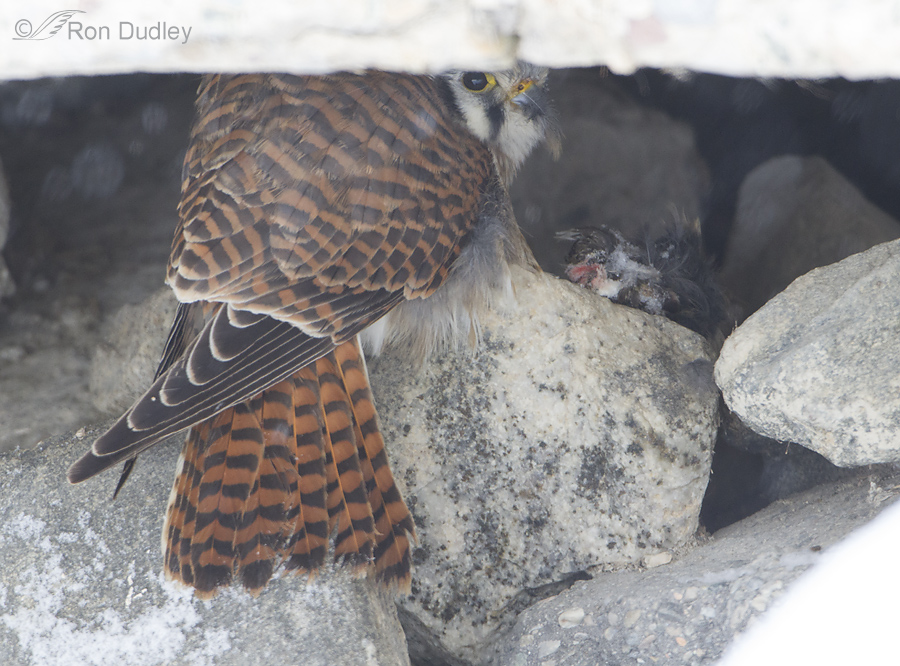
Thank you for another entertaining and informative story, and I especially liked the bit about the flight feathers in the snow.
Simply spectacular Ron! Thanks for sharing!
A long time ago I found some wings and didn’t know the species. Seeing this detail has confirmed it for me.Great story here.
A story of persistence paying off, and well illustrated too.
Wonderful series of photographs and really interesting narrative! I echo all the good stuff your loyal fans have already said. Hope your Kestrels continue to fare well!
As usual, your photos are outstanding but your commentary and detailed observations are the big draw for me. I really look forward to my daily dose of Professor Dudley and Feathered Photography. By the way, I am seeing more Kestrels this winter than I have in the last few years. Is that your impression as well or is it just wishful thinking on my part?
Dennis, what you said about my commentary means a lot to me. Thanks.
The number of kestrels around here during the summer was noticeably depressed but those numbers in the valleys have blossomed with the onset of winter.
She looks like a survivor to me! Really neat photo sequence Ron. I love it when behaviors are captured. You’ve illustrated some interesting stuff here. Commendable.
Bryce, I know you’re as much a fan of behaviors as I am. Thank you.
Many diurnal raptors, even as new fledglings, are hardwired to seek “shelter” from anything they feel may realize they have prey. Aerial threats for kleptoparasitism probably rank at the top of those that might present a risk. Death is also a possible outcome from a larger bird. So to avoid those possible situations cover, in the form of brush, forms the easiest solution but cavity nesters (like our Kestrels) will seek anything cavity like. Our Kestrels will nest under small overhangs on cliffs or in cave like “cavities” on cliffs. So going under a raised slab on concrete is no real stretch in a time of need.
I see separated vanes or filaments of tail feathers regularly as a result of contact against the direction of those feather parts with vegetation or ground but that situation is easily “repaired” with preening. Broken vanes or filaments of course can not be fixed but are replaced with the seasonal or annual moult.
Bill
Interesting…didn’t realize Kestrils were cavity nesters…and that our grand national symbol was actually nothing more than keptoparisite! Who knew!!!
As always you present interesting information, Bill. Thank you.
In watching this particular bird that morning it’s my suspicion that the primary reason she went under the concrete was to find a snow-free spot to eat.
When you show us a series like this, it’s almost like being there….
Good! That means I’ve done my “job” competently, Patty.
What a beautiful, ingenious and tenacious bird. What a glorious story to have unfold before me this morning. Megathanks.
Yes, she’s a great bird in all the ways you mention, Elephant’s Child. I hope to see her most days I’m out there this winter.
As always a wonderful set of pictures and a great story. What a very nice Christmas present. Merry Christmas!
Len
Merry Christmas to you too, Len.
Thanks for sharing this experience. Especially love the first photo – absolutely precious, and stunning contrast of her gorgeous colors against the snow. Nice!
Thank you, Patricia.
Hi Ron, A wonderful story well told.
I notice that In each of he images, her tail feathers look worn (especially noticeable in the later images, after she had been in the wet snow). I suspect that is because she has gone to the ground on many hunting forays. From your description, it appears those forays are working out! A survivor, indeed. Thanks!
Cheers,
Dick
Dick, so far I’m not seeing any particularly alarming signs that the raptors out there (including kestrels) aren’t coping pretty well. Hope it keeps up.
I yield my title of poor, pitiful(because of computer harassment) Patty to the poor, pitiful, pipit…however, I’m so very, very glad the kestrel found food! These are wonderful images, I especially love the one of her peeking over her shoulder while under the cement slab. Again, I’m surprised by her going down underneath something so low to the ground to feed. Her survivor instincts, so far, look good. She does what she has to do to survive…so, hopefully, she will. I am horrified that airboats are allowed anywhere near a protected area….We lived in Florida and found them to be incredibly loud and disturbing to wildlife. I’m surprised electric motors are not required…seems like a “no brainier”. I’d think those who like to sneak up and kill things would prefer them…..You’re not only a great wildlife photographer, but a darned storyteller, as well, Ron! (I like the little “feather alfalfa” on top of her head)…
Patty, Farmington isn’t a bird refuge (though some folks call it that) – it’s a waterfowl management area. Good or bad, duck hunting is a large reason for its existence. The water of the larger ponds is only a few inches deep and air boats are pretty much required (propellers would be in the mud). The noise from the air boats makes me mad – no other way to say it.
Got it…still, the effect is that of a jumbo jet flying through your bedroom….
Love it!
Thanks, Nala.
Ron: Feathers tend to fall quill (calamus) end (anlage) first because that end is heavier and offers less resistance than the area of internal and external vanes. They often will have a flight similar to the Maple tree’s seed, twirling as they descend to the ground.
Bill
That makes sense, Bill.
What a wonderful set of photos! I love the story you told – well worth the length. Thanks Ron!
I’m glad you liked the story, Gail. Thank you.
Excellent, Excellent, Excellent, Love these behavioral picture essays. Many thanks for sharing.
I’m like you regarding behavior shots, Dick. Given the choice of beautiful, technically perfect photos of birds or interesting behavioral shots I’d have a hard time choosing.
This is an absolutely wonderful story and set of pictures. It must have been very special to be there and see the story unfold in person. Thank you for starting my day so beautifully.
Special it was, Susan. Very.
What a story. Pictures are worth a thousand words! I feel like I was with you witnessing this entire event. Thanks Ron.
Thanks, Ellen.